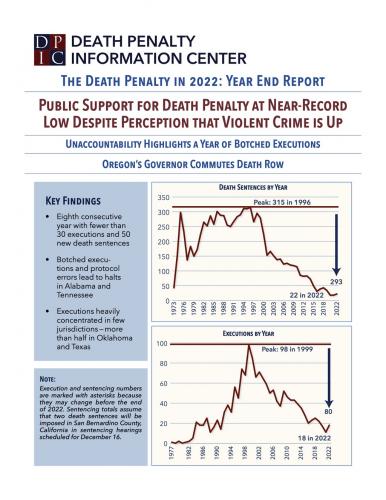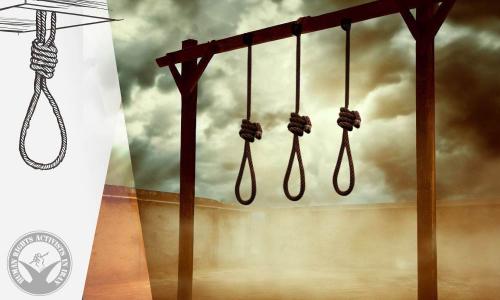20 December 2022 :
DPIC 2022 Year End Report: Commutation of Oregon Death Row Headlines U.S. Death-Penalty Decline in a Year Marred by Botched Executions.
The death penalty continued its long-term decline in the U.S. in 2022, as Oregon commuted its death row and new death sentences and public support for the death penalty remained near 50-year lows. But perhaps more dramatically than anything else, the fortieth anniversary of lethal injection could be known as “the Year of the Botched Execution,” the Death Penalty Information Center said in its 2022 Year End Report.
Oregon Governor Kate Brown cleared the state’s death row on December 13, commuting the sentences of the 17 prisoners facing potential execution in the state and instructing the department of corrections to begin dismantling the state’s execution chamber. It was the second largest blanket death-row commutation in the past 50 years, trailing only Illinois Governor George Ryan’s grant of clemency to 167 death sentenced prisoners in January 2003. It also marked the fifth straight year in which a state either abolished the death penalty, imposed a moratorium on executions, and/or commuted death row.
In a year that featured incendiary political advertising that drove the public’s perception of rising crime to record highs, nearly every measure of change — from new death sentences imposed and executions conducted to public opinion polls and election results — pointed to the continuing durability of the more than 20-year sustained decline of the death penalty in the United States. For the eighth consecutive year, fewer than 50 new death sentences were imposed in the United States and fewer than 30 executions were carried out in 2022. Excluding the pandemic years of 2020 and 2021, the 22 death sentences in 2022 were the fewest since capital punishment resumed in the U.S. in 1972 and the 18 executions were the fewest since 1991.
Death sentences and executions have both fallen dramatically from their peak usage in the 1990s. Death sentences in 2022 were 93% below the peak of 315 in 1996. Executions have dropped by 82% since their peak of 98 in 1999. The number of people on death row across the country also declined for the 21st consecutive year, with resentencings to life or less again outpacing the number of new death sentences. As of April 1, there were 2,414 people on death row.
At the end of 2022, 37 U.S. states had either abolished the death penalty or had not carried out an execution in more than a decade.
When states did schedule executions, the results were problematic. Thirty-three of the 51 scheduled executions (65%) did not go forward. Seven of the 20 executions that were attempted were visibly problematic — an astonishing 35% — as a result of executioner incompetence, failures to follow protocols, or defects in the protocols themselves.
“After 40 years, the states have proven themselves unable to carry out lethal injections without the risk that it will be botched. The families of victims and prisoners, other execution witnesses, and corrections personnel should not be subjected to the trauma of an execution gone bad,” said Robert Dunham, DPIC’s Executive Director.
The death penalty continued to be geographically isolated with only six states — Alabama, Arizona, Oklahoma, Mississippi, Missouri, and Texas — carrying out executions. Oklahoma (5) and Texas (5) performed more executions than any other states; together they conducted more than half of the year’s executions. Oklahoma’s decision to schedule 25 execution dates over the next two years marked the state as an outlier, even among states that regularly schedule executions.
Twelve states imposed new death sentences this year. California and Florida imposed four each (assuming two death sentences scheduled to be imposed in San Bernardino County, California on December 16 are imposed), and Alabama imposed three. San Bernardino is expected to be the only county in the country to impose more than one death sentence this year.
The vast majority of those executed in 2022 were individuals with significant vulnerabilities. At least 13 of the people executed in 2022 had one or more of the following impairments: serious mental illness (8); brain injury, developmental brain damage, or an IQ in the intellectually disabled range (5); chronic serious childhood trauma, neglect, and/or abuse (12). Three prisoners were executed for crimes committed in their teens. At least four of the people executed this year were military veterans.
Alabama, Arizona, and Texas had botches when execution teams were unable to set IV lines, leading to cancelled executions or delays of hours. On July 28, 2022, executioners in Alabama took three hours to set an IV line before putting Joe James Jr. to death, the longest botched lethal injection execution in U.S. history. Executions were put on hold in Alabama, Idaho, Ohio, Tennessee, and South Carolina when the states were not able to carry out execution protocols.
Public opinion polls in 2022 showed support for capital punishment remained near historic lows, even amid rising perceptions of crime. A poll released in February found that Americans’ support for the death penalty was even lower when asked about the classes of defendants who are most frequently subject to the punishment. Democrats, Republicans, and Independents by margins of more than 30 percentage points opposed the use of the death penalty against people with severe mental illness, brain damage, or intellectual impairments, and against veterans with posttraumatic stress disorder.
At the ballot box, candidates who had imposed or promised to continue execution moratoria won election in California, Oregon, and Pennsylvania, and reform prosecutors were elected or reelected in counties across the country.
The Death Penalty in 2022: Year End Report











